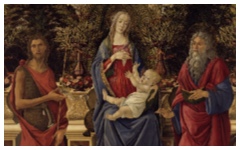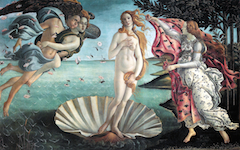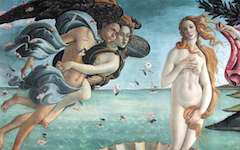Botticelli’s St. Sebastian (c.1473)
We have seen elsewhere how Botticelli's Birth of Venus is divided between two realities, that of the 3-D studio and the 2-D work of art. Here in his painting of St. Sebastian, Botticelli manages the same transition in a much more subtle manner. Mystic Christians often Imitated the life of a saint in their attempt to reveal the divine essence within themselves. In the same manner Sebastian's body has often been used by great artists as both a symbol for the suffering they themselves endure in creative work and for the "art" within the painting. The saint tied to the wooden stake stands on a small ledge like a panel on an easel, his violent death symbolizing the creation of the work itself.
Click next thumbnail to continue
Take a look now at the saint's feet. One is portrayed in such foreshortened perspective that it appears flattened, firmly locked within the painting. The other, though, moves forward into our space, an effect emphasized by showing it much larger and in semi-profile. It appears, so to speak, to move into the studio space in front of the painting thus bridging two realities. In a number of Old Master paintings, none yet published, toes are used like this to represent the artist's "hand" because, in both French and Italian, toes are spoken of as "fingers of the foot".1 Thus, the artist's "fingers" are in both the painted background and the studio-foreground like an artist painting himself.
Click next thumbnail to continue
The action of painting is further stressed by the use of arrows to represent "paintbrushes" fired in, metaphorically speaking, from the studio in front of the painting. (Wooden panels might even have been used in archery practice, as they are today, as inexpensive targets.)2 Besides, the shafts of the arrows are so foreshortened that they too appear to begin, from the notched-end, in the artist's space.
Botticelli was one of several Renaissance artists known in his own day as having the habit of painting himself no matter whom he was actually portraying, fictive or real.3 This new insight, then, is just further support for what his contemporaries already knew.
More Works by Botticelli
Notes:
1. Les doigts de pied in French and i diti di piedi in Italian.
2. I have seen targets shaped like this panel, flat and arched at the top, used in archery practice and competitions in the Himalayas.
3. "“Fra Filippo Lippi and Sandro Botticelli often repeated their own physiognomies in almost any face in their paintings because they simply could not avoid painting themselves. Our concept of physiological likeness may be different from corresponding concepts of the Renaissance beholder but the visual evidence seems to confirm that in fact both Filippo Lippi and Sandro Botticelli painted themselves.” Frank Zöllner, “ ‘Ogni Pittore Dipinge Sé’: Léonardo da Vinci and ‘Automimesis’ ”, Künstler über sich in seinem Werk, ed. M. Winner (Weinheim: VCT Acta humanoria) 1992, p. 139
Original Publication Date on EPPH: 21 Jun 2012. | Updated: 0. © Simon Abrahams. Articles on this site are the copyright of Simon Abrahams. To use copyrighted material in print or other media for purposes beyond 'fair use', you must obtain permission from the copyright owner. Websites may link to this page without permission (please do) but may not reproduce the material on their own site without crediting Simon Abrahams and EPPH.






